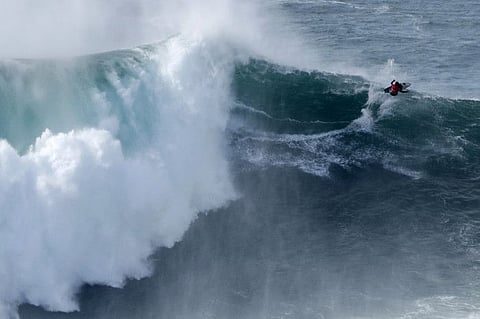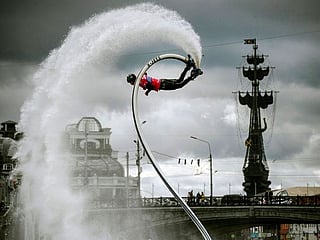"I heard crunch, crunch, crunch, crunch": A surfer wanted to catch waves from Hurricane Lee. A shark bit his face
A shark had sunk its upper teeth into the right temple are of surfer Mark "JoJo" Sumersett

Surfer Mark "JoJo" Sumersett could feel the sharks surrounding him.
He'd seen at least a dozen swimming at New Smyrna Beach, Fla., by 8 a.m. Sept. 12. It had been a little more than 24 hours since he'd rushed down from his home in Charleston, S.C., to surf the "gnarly" waves that Hurricane Lee was pulsing into the East Coast as the storm barreled north in the Atlantic.
"I'm scared to death, but the waves are so good," the 38-year-old said.
About an hour into his second day of surfing, Sumersett caught his fourth or fifth wave of the morning and shot his board to the crest before cutting back the other way - right toward "the kill zone where the most sharks are." Approaching a jetty, he jumped into about seven feet of water.
Then, it happened.
"This huge pressure just hit my face. It felt like a bear trap was closing in on my face," he told The Washington Post. " . . . I heard crunch, crunch, crunch, crunch."
A shark had sunk its upper teeth into the area around his right temple and the lower teeth into the left side, just off Sumersett's chin. It was gone before he saw anything, leaving Sumersett stunned. He soon realized he was gushing blood into the water and not out of danger.
"I'm like, 'Holy crap, you're bleeding. This shark is coming back.'"
Unsure whether he'd make it, he started paddling toward the shore.
Sumersett and his friend, former professional surfer Anthony Osment, had spent a week planning a trip to ride the waves that the storm would push into the East Coast. Unable to sleep Sept. 10, they left Charleston a little before midnight. They drove 51/2 hours through the night on forecasters' promise that, starting the next day, Lee would send bigger and bigger waves to the shore.
There would be none better than the ones at New Smyrna.
"We were chasing the swell," Sumersett said.
Sumersett and Osment arrived at the beach around 5:30 a.m. ready to go. Within 10 minutes of getting in the water, Sumersett spotted a shark fin, and after catching a few waves, he saw another - reminders of why New Smyrna has been informally dubbed the "shark bite capital of the world."
Alarmed, Sumersett looked around and noticed that other surfers were unbothered, leading him to believe it was normal and nothing to worry about. Sumersett kept surfing.
Around noon, he watched a six-foot-long spinner shark leap out of the water 20 feet away and fall back in, barely missing another surfer. Sumersett was terrified but stayed in the water. Several other surfers, including the one nearly bodied by the spinner shark, seemed unbothered.
He kept surfing.
He saw another shark fin in the afternoon.
Kept surfing.
Around dusk, he watched three sharks "come swimming through the waves like dolphins do."
Kept surfing.
Five minutes later, he saw three different sharks doing the same thing.
Kept surfing.
After 12 hours in the water, Sumersett and Osment crashed at a nearby hotel. They woke up early the next morning and hit the beach before sunrise. Sumersett said he talked about sharks the whole 30-minute trip from the hotel.
He caught three or four good waves, even surfing through the barrel of one of them as it broke over his head, getting "tubed."
"I was super stoked," he said.
Then, Sumersett caught another, at one point shooting his board to the top before cutting back toward the jetty. His ride was over. Normally, he would have kicked his legs out so he could lie face down on his board and paddle back out. But because the wave was big - they were five and six feet by then - he jumped into the water.
"The shark was probably right beside me," he said, adding that he thinks his gold chain may have attracted its eye.
It bit down, released its grip and swam off before he knew it was there.
Sumersett's first thought: You knew you were going to get bit. It happened, and now it's over. Paddle in, take care of the bite wound and paddle back out to catch more waves.
Then he touched his face and pulled his hand away - it was covered in blood. He felt the cuts on the upper right side of his face near his temple.
"Huge laceration - deep, gnarly - like I could touch my skull," he said.
He hopped up on his board and rode a wave to the beach. A fellow surfer ran up to him before corralling a woman who called 911. Another surfer, who was a doctor, asked Sumersett random questions, calming him down and preventing him from going into shock.
About 10 minutes later, lifeguards showed up. They wrapped his head in gauze, loaded him into their truck and drove him about 15 minutes down the beach before transferring him into an ambulance. Before seeing him off, they swabbed his wound for DNA, which would allow them to identify the species of shark that bit him.
Paramedics took him to a hospital in Daytona Beach, Fla., where a plastic surgeon sewed up his wounds with 19 stitches.
Doctors told him it could have been worse. If the shark had bitten him two inches to the right, its teeth might have severed his carotid artery, killing him. If it had bitten him a little to the left, it could have put out his right eye. Instead, he spent three hours in the hospital before doctors sent him on his way.
Sumersett said he'll need more surgeries, although he's not sure how many or when they'll happen. In the meantime, he's already back to work as a carpenter in Charleston. He plans to get his stitches out Wednesday and surf later that day if the waves are good.
But will he ever surf New Smyrna Beach again?
Never, he said.
Then, Sumersett paused.
"Who knows? You know what, I'm not going to lie. If I'm there, and it's firing and it's bombing - like there's really good waves there -"
He paused again.
"I might."
Sign up for the Daily Briefing
Get the latest news and updates straight to your inbox







